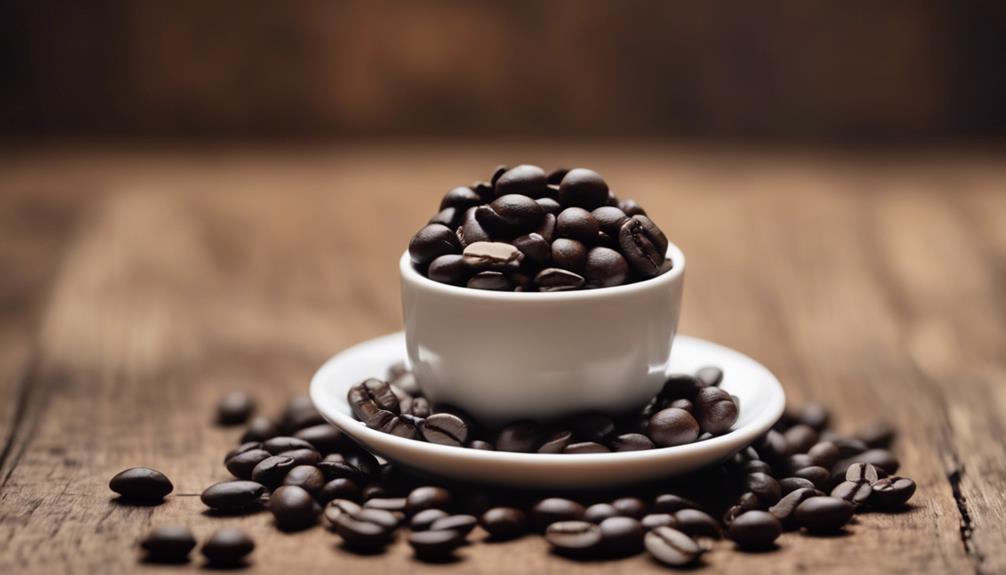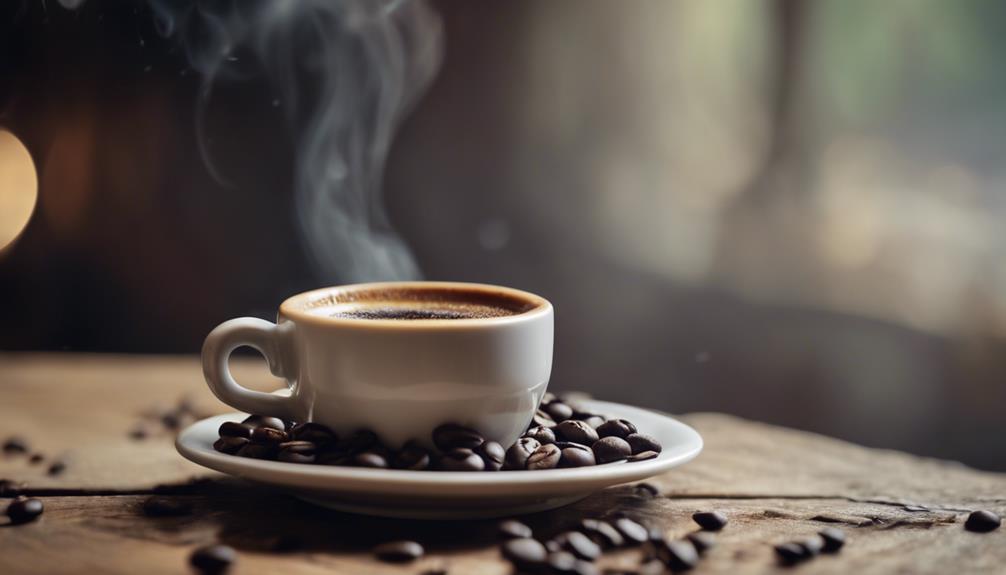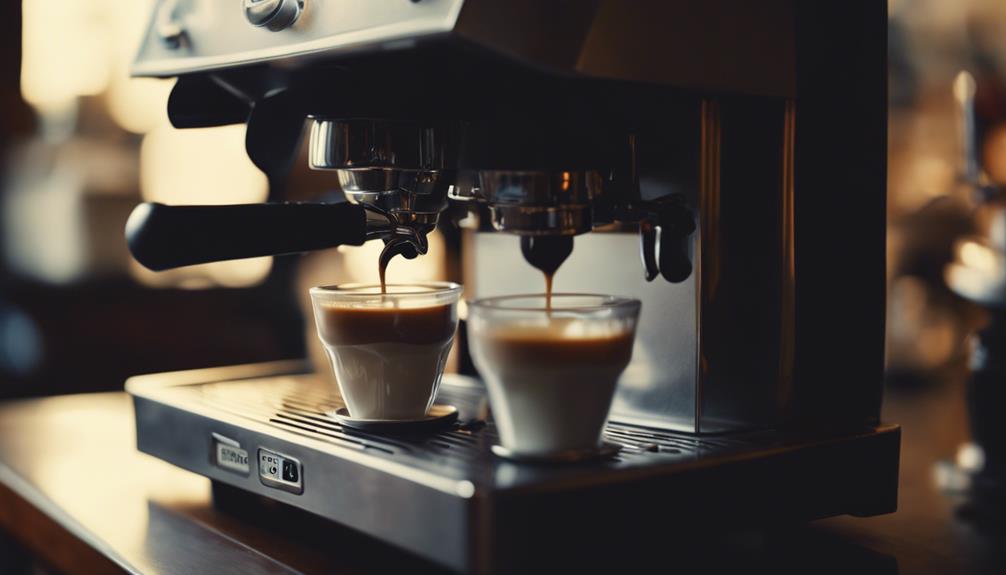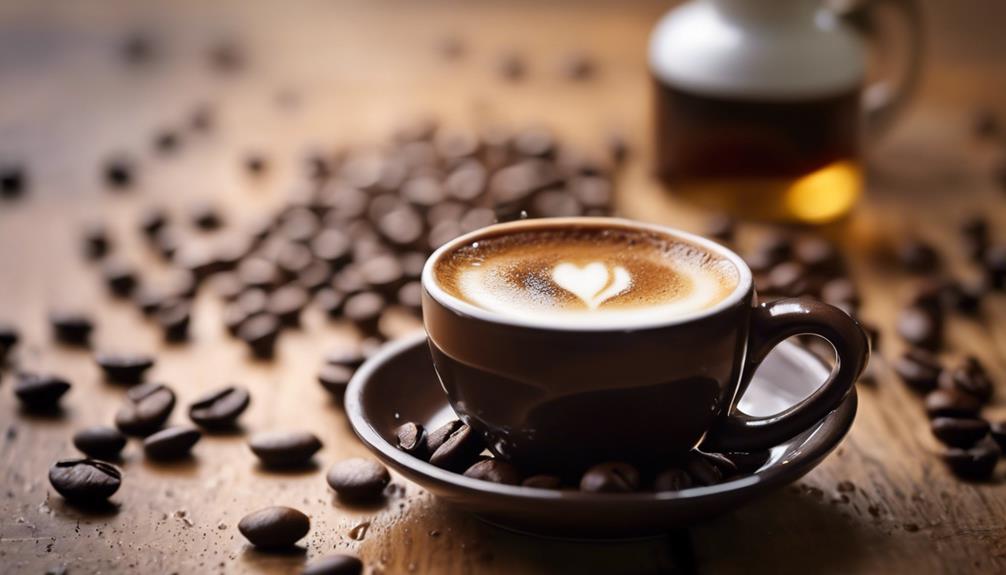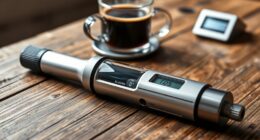You are on the brink of uncovering the distinction between espresso beans and coffee beans, with espresso beans being roasted longer and darker resulting in bolder flavors and higher oil content, leading to a more uniform taste profile. Arabica and Robusta beans are commonly used for espresso, while Liberica and Excelsa are typically used for coffee. Darker roasts enhance strong flavors in espresso, whereas lighter roasts maintain the original flavors in coffee. The grind size and brewing method also differ significantly between the two. As you delve into the intricacies of these beans, you will reveal a vast array of flavors and brewing techniques just waiting to be explored.
Key Takeaways
- Espresso beans are typically roasted darker and longer than coffee beans, resulting in bolder flavors and higher oil content.
- Espresso beans require a finer grind than coffee beans to maximize oil extraction and flavor in high-pressure brewing.
- Espresso beans have a narrower flavor spectrum and higher bitterness concentration compared to coffee beans, which offer a broader range of flavors.
- Brewing methods and grind sizes differ significantly between espresso and coffee, with espresso requiring high-pressure machines and fine grinds.
Bean Types and Roasting Explained
When you explore the world of espresso and coffee, you'll quickly realize that the type of bean and its roast level play an essential role in shaping the flavor and overall character of your brew.
Espresso beans, typically roasted darker and longer than regular coffee beans, bring out a bolder flavor and higher oil content. Most espresso beans are either Arabica or Robusta, whereas coffee beans encompass a broader range of varieties like Liberica and Excelsa.
The roast level has a significant impact on flavor profiles. Lighter roasts preserve more of the original bean flavors, while darker roasts produce bolder, more bitter notes. Dark-roasted espresso beans, in particular, exhibit a shiny, oily appearance due to the extraction of natural oils during the roasting process.
This distinct roasting process is what sets espresso beans apart from coffee beans, resulting in a unique flavor experience. By understanding the differences in bean types and roasting, you'll be better equipped to choose the perfect beans for your brewing needs.
Grinding Techniques and Oil Content
By adjusting the grind size of your beans, you're able to control the amount of oil extracted, which greatly impacts the flavor and texture of your espresso or coffee.
When it comes to grinding techniques, espresso beans require a finer grind to maximize oil extraction, resulting in a rich crema and intense flavor. On the other hand, regular coffee beans are typically ground coarser, as they're brewed using methods that don't require high pressure.
Here are some key differences to keep in mind:
- Grind size: Espresso beans are ground finely, while regular coffee beans are ground coarser.
- Oil content: Espresso beans have a higher oil content, resulting in an oily sheen, whereas regular coffee beans appear dry.
- Extraction levels: The grind size and oil content affect the extraction levels, which impact the flavor and texture of your brew.
- Consistency: Consistency in grind size is essential for both espresso and coffee to avoid uneven extraction and inconsistent flavor.
Flavor Profiles and Brewing Methods
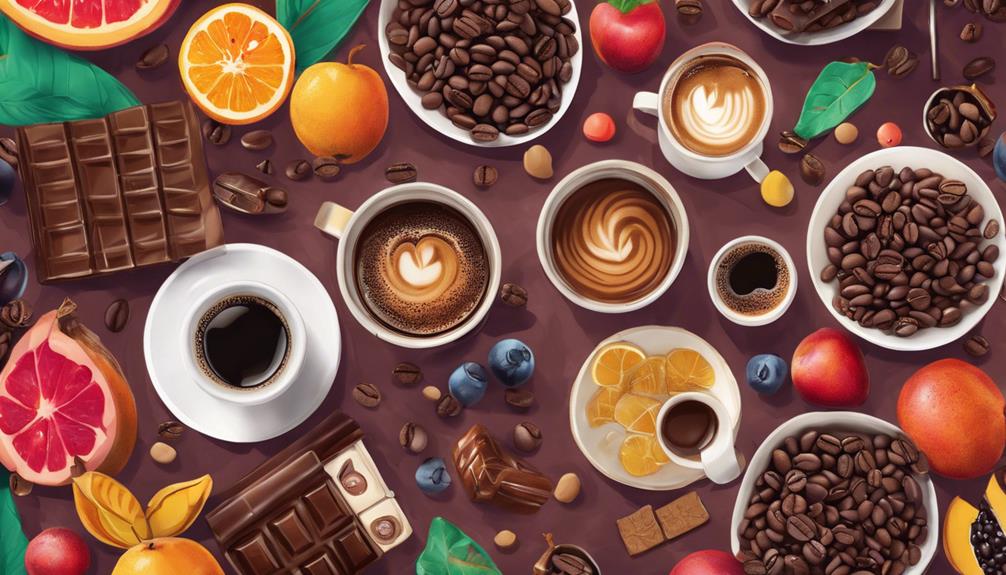
You'll notice distinct flavor profiles emerging when you explore the roasting and brewing methods used for espresso beans versus regular coffee beans. The darker roasting of espresso beans results in a bolder, more concentrated flavor profile with notes of chocolate and caramel. In contrast, coffee beans can exhibit a wider range of flavors due to varying roast levels, from fruity and floral to nutty and chocolatey.
The brewing method also plays a significant role in shaping the flavor profile. Espresso's high-pressure brewing process requires finely ground beans, creating a rich crema and thicker texture. Coffee, on the other hand, can be brewed using various methods like drip or French press, which require coarser grind sizes.
This difference in brewing technique affects the final flavor, with espresso having a higher concentration of bitterness and a stronger, richer taste despite having less total caffeine. By understanding the unique characteristics of each, you can optimize your brewing techniques to bring out the best flavors in your espresso and coffee beans.
Caffeine Content and Concentration
When you're deciding between espresso and regular coffee, you're likely considering the caffeine kick.
You might assume that espresso, with its intense flavor, packs more caffeine per ounce than coffee, and you're right – it does.
But how much more, and what does that mean for your daily caffeine intake?
Caffeine Per Ounce
On average, you get a more intense caffeine kick from espresso, with approximately 63 milligrams of caffeine packed into a single 1-ounce shot. This higher caffeine concentration per ounce is due to the unique brewing method used for espresso, which involves forcing pressurized hot water through finely ground coffee beans.
In contrast, an 8-ounce cup of brewed coffee typically contains around 95 milligrams of caffeine, but the larger serving size means total caffeine consumption can vary greatly.
Here are some key points to keep in mind when comparing the caffeine content of espresso and coffee:
- Espresso beans generally have a higher caffeine concentration per ounce than coffee beans due to the brewing method.
- The type of beans used, such as Arabica beans or Robusta beans, can affect the overall caffeine levels in both espresso and coffee.
- The brewing method employed can also impact the caffeine content, with espresso's high-pressure brewing process resulting in a more concentrated beverage.
- Despite its higher caffeine concentration per ounce, a serving of espresso usually has less total caffeine compared to a full cup of brewed coffee due to the smaller serving size.
Espresso Vs Coffee
Your daily pick-me-up likely involves a choice between espresso and coffee, but what sets them apart regarding caffeine content and concentration?
When it comes to espresso vs coffee, the difference lies in the caffeine concentration per ounce. Espresso typically packs around 63 mg of caffeine per 1 oz shot, resulting in a higher caffeine concentration compared to drip coffee. However, a standard 8 oz cup of coffee may have around 95 mg of caffeine, but due to its larger serving size, you'll likely consume more caffeine overall.
The type of coffee beans used and brewing method can affect the caffeine content in espresso, whereas regular coffee's caffeine level is influenced by brewing time and method.
This difference in caffeine concentration also impacts the flavor profile. Espresso is characterized by a high concentration of bitterness, while regular coffee has a medium concentration, affecting the overall flavor experience.
Despite its higher caffeine concentration, espresso is usually consumed in smaller amounts, leading to a distinct caffeine experience.
Espresso Vs Coffee: Cultural Significance
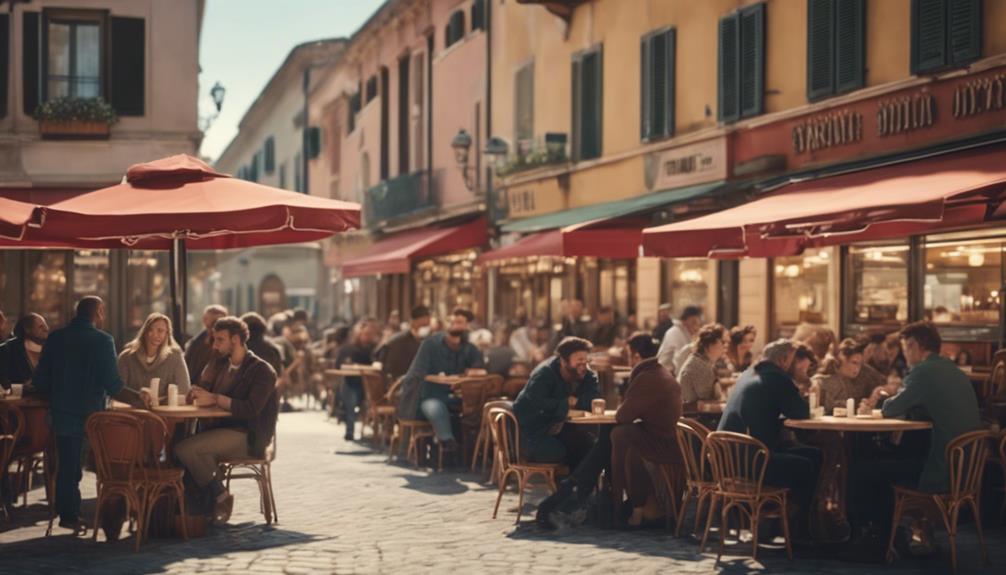
As you explore the world of coffee, it becomes clear that espresso and coffee have developed distinct cultural identities, reflecting different values and experiences. Espresso, in particular, has become an integral part of Italian coffee culture, where it's often enjoyed as a standalone shot, emphasizing quality and craftsmanship.
Here are some key aspects of their cultural significance:
- Espresso-centric culture: Espresso is deeply rooted in Italian tradition, where it's savored as a strong, rich shot, often accompanied by socializing and conversation.
- Global popularity of espresso-based drinks: Lattes, cappuccinos, and other espresso-based drinks have gained widespread popularity, showcasing the versatility of espresso when blended with milk.
- Shift towards transparency and quality: The third-wave coffee movement has shifted focus from traditional espresso-centric culture to lighter roasts and single-origin beans, highlighting transparency in sourcing and quality.
- Brewed coffee's cultural adaptability: In contrast, brewed coffee has been adopted and appreciated in various formats across different cultures, often consumed in larger quantities and enjoyed for its unique flavors and aromas.
As you investigate deeper into the world of coffee, you'll discover that these cultural differences have a significant impact on the way we perceive and enjoy espresso beans and coffee.
Preparation Methods and Bean Selection
You'll find that the cultural significance of espresso and coffee plays out in the preparation methods and bean selection, where the nuances of roasting, grinding, and brewing techniques come into sharp focus.
When it comes to espresso, you'll typically use beans that are roasted longer and at higher temperatures, resulting in a dark roast that enhances oil extraction and creates a rich, concentrated flavor profile. This requires a fine grind size for ideal extraction under pressure.
In contrast, coffee beans can be roasted to various levels, and their grind size can vary depending on the brewing method. The choice of beans also affects the brewing method, as espresso requires high-pressure techniques, whereas regular coffee can be prepared using a variety of methods with more versatility.
By understanding the differences in roasting and grinding techniques, you can select the appropriate beans to achieve the desired flavor and strength in your final brew.
Whether you're an espresso aficionado or a coffee connoisseur, the right beans and preparation methods can make all the difference in the flavor profile of your cup.
Roast Levels and Flavor Characteristics
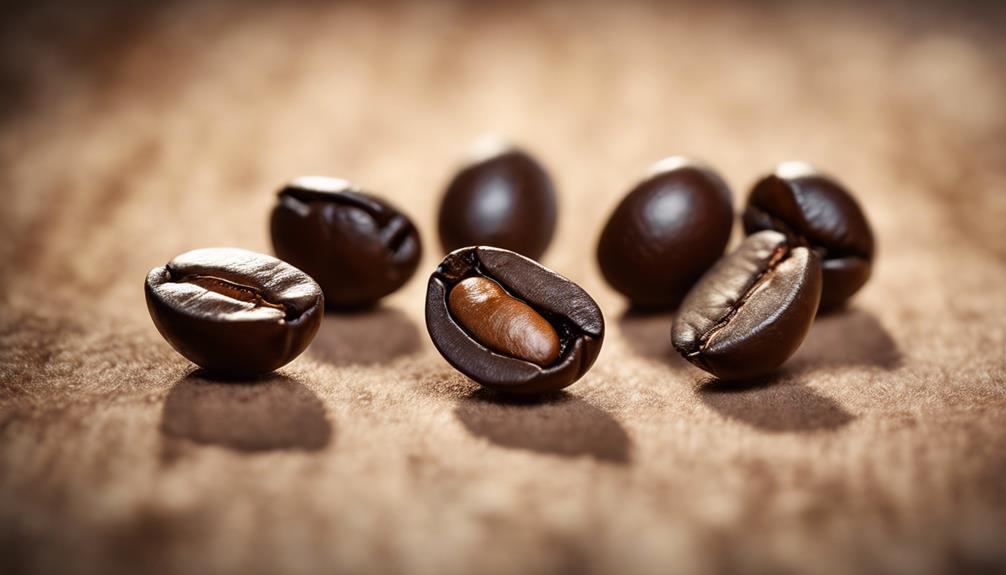
By delving into the world of roast levels, you discover that the duration and temperature of the roasting process dramatically impact the flavor characteristics of both espresso and coffee beans. The roasting process can bring out distinct flavors, aromas, and textures in your brew.
Here are some key differences in roast levels and flavor characteristics between espresso and coffee beans:
- Darker roast for espresso: Espresso beans are typically roasted for a longer duration and at higher temperatures, resulting in a darker roast that imparts a bold and intense flavor profile.
- Lighter roasts for coffee: Coffee beans can be roasted to various levels from light to dark, affecting their taste and aroma. Light-roasted coffee beans retain more of the original flavors of the bean.
- Flavor profiles: Dark-roasted espresso beans often exhibit flavors of chocolate, caramel, and a distinctive bitterness, while coffee beans may present a broader range of flavors including fruity, floral, or earthy characteristics.
- Oil content and brewing: The roasting process for espresso beans leads to a higher oil content, contributing to the oily sheen and rich crema produced during brewing, which isn't present in lighter-roasted coffee beans.
Understanding the roast levels and flavor characteristics of espresso and coffee beans can help you make informed choices when selecting beans for your brewing method.
Espresso Beans Vs Coffee Beans: Key Differences
Now that you've got a sense of the roast levels and flavor characteristics, it's time to explore the key differences between espresso beans and coffee beans. When it comes to the espresso vs coffee difference, one of the main distinctions lies in the grind size. Espresso beans are typically ground to a finer consistency than regular coffee beans, allowing for a quicker extraction process and a more concentrated flavor. Additionally, espresso beans are often a blend of different coffee beans, carefully chosen and roasted to create a balanced and bold flavor profile, while regular coffee beans can come from a single origin or a blend and are typically roasted to highlight their specific flavor notes.
You'll notice that the roast level of espresso beans is a game-changer, and it's not the only thing that sets them apart.
As you'll see, the brewing methods used for each type of bean are distinct, and that's what makes all the difference.
Roast Level Matters
What sets espresso beans apart from their coffee counterparts is the roast level, which profoundly impacts the flavor profile of your brew.
As you explore the world of coffee, you'll find that espresso beans are typically roasted longer and darker than regular coffee beans. This results in a bolder and more intense flavor profile.
Here are some key differences in roast level between espresso beans and coffee beans:
- Darker roasts: Espresso beans are usually associated with dark roasts, which enhance their oil content and give them a shiny, oily appearance.
- Bolder flavor: Darker roasts result in a bolder and more intense flavor profile, perfect for espresso's high-pressure brewing method.
- Higher bitterness: The roast level influences the acidity and bitterness of the brew, with espresso exhibiting a high concentration of bitterness due to its darker roast.
- Limited flavor range: Unlike coffee beans, which can be roasted to various levels, espresso beans are usually limited to dark roasts, resulting in a narrower range of flavors.
Brewing Methods Differ
You're about to discover how the brewing methods for espresso beans and coffee beans differ markedly, and it all starts with the equipment and grind size required for each.
When brewing espresso, you'll need a high-pressure machine and a fine grind to guarantee ideal oil extraction. This results in a concentrated flavor that's characteristic of a well-made espresso shot.
In contrast, coffee beans can be brewed using various methods like drip, French press, or pour-over, which require a coarser grind.
The brewing time also varies greatly, with espresso taking around 25-30 seconds and regular coffee methods taking anywhere from 4-12 minutes. This shorter brewing time is what gives espresso its distinctive flavor profile.
If you try using regular coffee beans for espresso, you might end up with a less intense flavor and no crema, which is a hallmark of properly brewed espresso.
Choosing the Right Beans for You
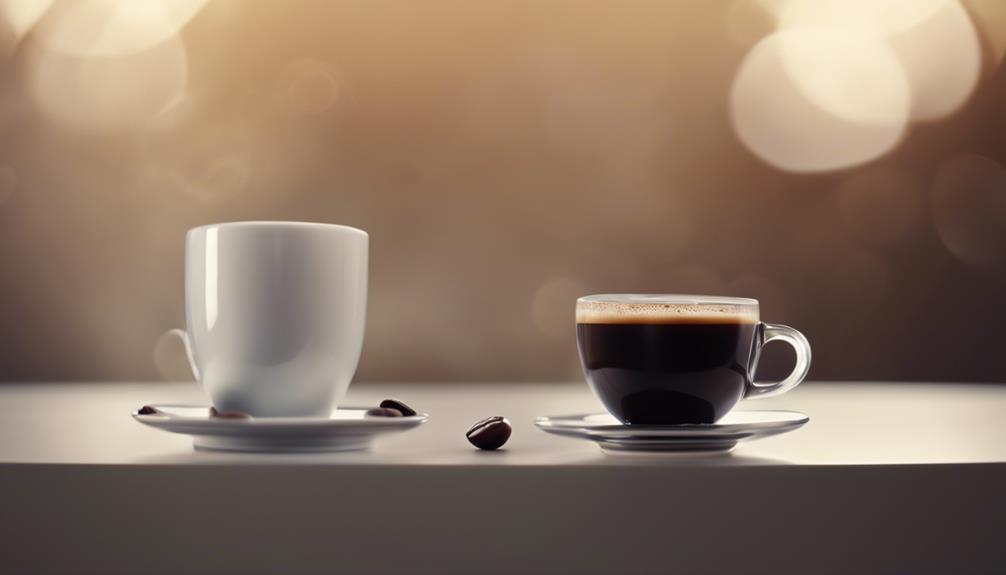
Your coffee journey begins with an essential decision: selecting the right beans for your taste buds. When it comes to choosing between espresso beans and coffee beans, consider your personal preference and the flavor profile you're aiming for.
Here are a few factors to keep in mind:
- Flavor Profile: Espresso beans offer a bold, full-bodied flavor, while coffee beans provide a wider variety of flavors.
- Roast Level: Dark-roasted espresso beans provide a consistent taste, while coffee beans can range from light to extra-dark, affecting flavor complexity.
- Brewing Methods: Espresso beans are ideal for espresso shots, lattes, and cappuccinos, while coffee beans are perfect for drip, pour-over, or French press.
- Experimentation: If you enjoy trying new things, you can use regular coffee beans in espresso-style drinks, but be aware that the taste may differ from traditional espresso.
Frequently Asked Questions
Are Espresso Beans and Coffee Beans the Same?
You're wondering if espresso beans and coffee beans are the same. Well, yes, they're both derived from coffee cherries, but the difference lies in their roasting and brewing methods, which affect their flavor profiles and textures.
Is Eating Espresso Beans the Same as Drinking Coffee?
You're wondering if eating espresso beans is the same as drinking coffee? Not quite – when you eat them, you get a concentrated burst of flavor and caffeine, whereas drinking coffee dilutes the experience.
What Are Espresso Beans Used For?
You're the master chef of your morning, and espresso beans are the secret ingredient that elevates your coffee game. You use them to craft rich, bold espresso shots, lattes, cappuccinos, and Americanos that awaken your senses.
How Is Espresso Different From Coffee?
You're wondering how espresso differs from coffee? Well, you'll notice espresso has a richer, thicker taste, higher caffeine concentration, and a bolder flavor with chocolatey notes, whereas coffee has a lighter taste and more varied flavors.
Conclusion
As you now know the secrets of espresso beans vs coffee beans, the choice is yours.
Will you join the rebels of the coffee revolution, sipping on a bold espresso, or will you side with the traditionalists, indulging in a warm cup of joe?
The clock is ticking, and the coffee gods are waiting – choose wisely, for in the immortal words of Alexander the Great, 'There is nothing impossible to him who'll try.'
